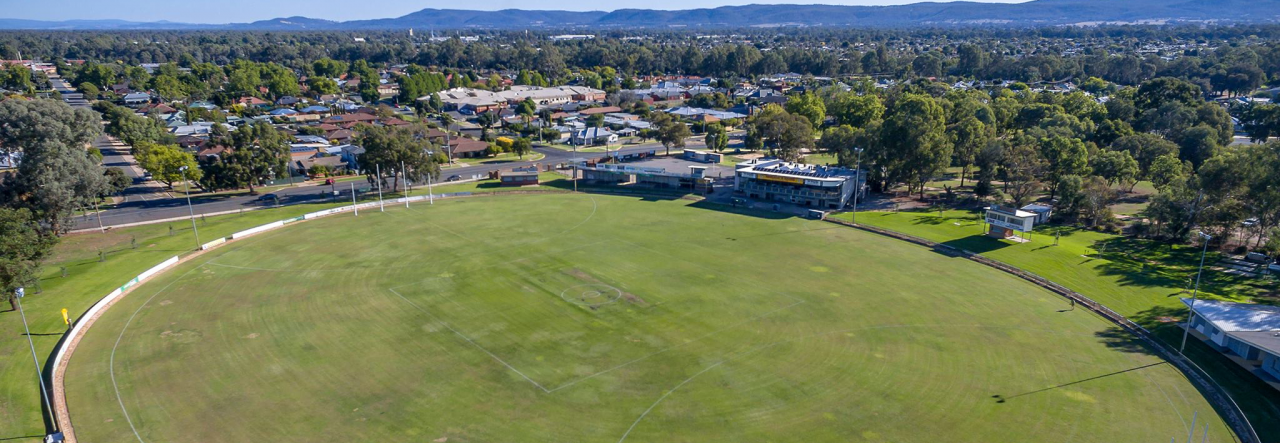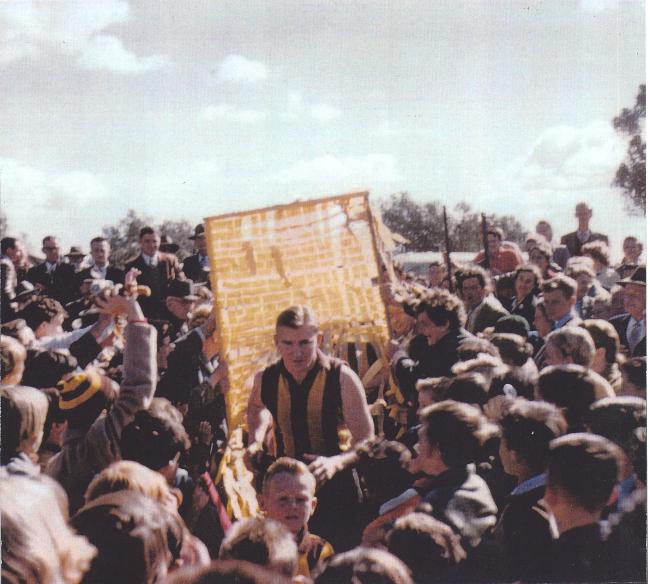Everyone with the remotest connection to the Wangaratta Rovers was abuzz with excitement as spring gave way to the summer of late 1955.
Mr.Football had come to town.
This wasn’t a whistlestop promotional visit at the behest of the VFL. No, the man popularly acknowledged as the best footballer in Australia, had arrived – with his wife Elsie and sons Robert and Peter – to take up his appointment as the playing-coach of the Wangaratta Rovers.
The procurement of Bob Rose to take the reins of a battling club stunned not only local fans, but footy people around the nation.
After all, the Rovers had been in existence for 11 years; had only gained admittance to the Ovens and Murray League in 1950 and were largely unsuccessful in that time.
It seemed ludicrous that Collingwood had allowed their champion player to be prised away by a bush club which appeared to have little or no credibility. And secondly ,why didn’t he take the offer of East Perth, which had promised to make him captain-coach and the highest-paid player in Australia ?
Those were the unanswered questions. But it was obvious that the Rovers had made a convincing presentation to the four-time Copeland Trophy winner. The hunt for a top-line coach had begun months earlier, but once the Hawks got the inkling that Rose may become available,they made him their target.
In their favour was that he had strong family ties in Victoria, which counted against a move to the west. Also, as a lad brought up in Nyah West, he liked the prospect of moving back to the country.
When he began to warm to the Rovers’ approach they formulated a package which included a sports store proprietorship and a salary of 35 pounds per week to coach the club.
He had many people suggesting that he would be foolish to give up his future at Collingwood and also advising him of the pitfalls of taking the job. Among those was the warning by a former team-mate that the Rovers were a ‘Catholic club’. He gave this little credence and decided that a trip to Wangaratta to have a look at the town would be a good idea.
Unfortunately, on his first attempt at the journey he had to head home ,as he realised that his old Singer car wouldn’t handle the steep inclines of the Hume Highway’s ‘Pretty Sally’. He rang the Rovers to postpone the appointment and headed north the following week in his brother Kevin’s flasher vehicle.
Manny Cochineas, a prominent Wangaratta businessman ,who had become a godfather-type figure at the Rovers (a’ la’ Colin Joss) was the man who planted the idea among his fellow officials that they should aim high and go for the best. ‘Cochy’ was a dreamer and relished the prospect of snaring Mr.Football against all odds.
Keith Ottrey, who was a star player of the fifties, remembers that the Rovers hierarchy did a great job of keeping the Rose-hunt under tabs. “It was a bit of a case of …’don’t tell the Arabs’. We weren’t told a thing. The only inkling I had that things were going all right was when I heard ‘Cochy’ whisper to a bloke , “I think we’ve got him”.
So, when they had indeed snared Bob Rose, preparations moved into full swing for the 1956 season.He and his young family settled into a small Housing Commission residence in Lamont Street. It was hardly salubrious but the Roses were unfazed. The Rovers later found them a house at 102 Swan Street, which became their abode for the rest of their time in Wangaratta.
With the task of setting up his new business and traversing the area on recruiting trips, life was pretty full-on for the new coach. But he was buoyed by the enthusiasm of the Rovers people .
He had to sit through some drama at the Club’s Annual Meeting in late November, when President Harry Klemm faced a no-confidence motion ,moved by his brother,Tom. Harry was deposed from the position and indeed, was voted off the 23-man committee.
But that was barely a ripple on the landscape, as new members clambered onto the Hawk bandwagon. The club’s first practice match attracted a crowd of 1,000 to watch Bob Rose and a new wave of recruits in action.
Unfortunately, in the lead-up to Rose’s much-awaited O & M debut against Benalla, he suffered a groin injury and had to watch from the sidelines, as his old Collingwood team-mate Len Fitzgerald led the Demons to victory.
A fortnight later he took to the field against Wangaratta and ,in a day of triumph ,led the Hawks to a nine-point win against the arch rival. He was chaired from the field by delighted supporters, who loved the influence he had exerted on his new charges.
After a slow start to the season, the Rovers won nine of their last 11 home and home games to sneak into the O& M finals for the first time.
Though beaten by Benalla in the first semi-final, Hawk supporters liked what they saw in 1956.And they positively adored the coach. Club membership had risen from 325 to 670 in 1956 and a new breed of supporter gained a fascination for the Brown and Gold.
Italian tobacco-growers, who had shown scant regard for footy ,were introduced to the game via the exploits of Rose, whom they called ‘Bobby Rossa’. They were generous and loyal and many became Hawks for life.
To young whippersnappers like yours truly, he was bigger than Ben Hur. It was an era of scant exposure of VFL players; you just relied on newspapers and footy cards to bring them to life.To have a superstar in our midst was beyond belief. We couldn’t wait for training nights and would race down to the ground to see what Guernsey he was wearing,or try to attract his attention whilst having kick-to-kick.
The Rovers doubled their profit in 1956 and well and truly covered the financial outlay .But more importantly,Rose developed a culture among the playing ranks which would set the standard for decades to come . He had lifted the profile of the club to unforeseen levels.
In the years to come he was to achieve fabulous personal and club success with the Hawks. Within two years the first of 15 flags was fluttering at the City Oval and he had won the first of his two Morris Medals.
The dream of Manny Cochineas and his mates had come to fruition.

